Home Exercises Part 4: Low Planks
This is our fourth blog post in the series where we put popular exercises under scrutiny to examine how they stack up—or not—against the principles of healthy posture. Here we are looking at “low plank,” a whole-body exercise that particularly develops abdominal strength and trunk stability.
Our model for the photographs is Eric Fernandez, our Gokhale Exercise teacher who teaches the Gokhale Method in the Philadelphia area.
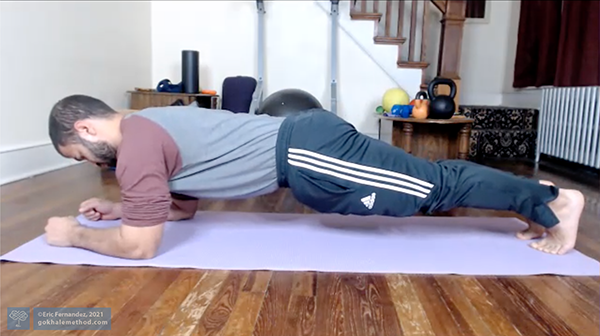
Low plank is done on the forearms, which avoids pressure on the wrists.
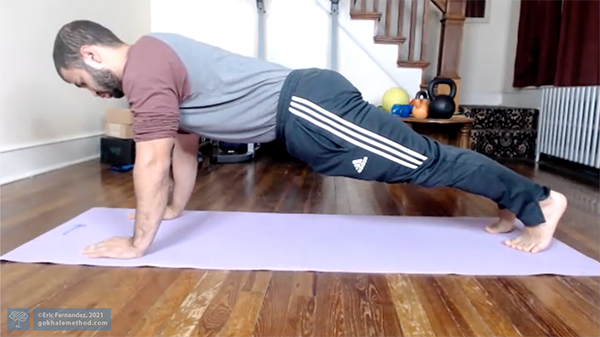
The classic version of this exercise with straight arms. Active hands and a slight bend at the elbows will likely ease strain on the wrists, but we recommend you do low plank first.
Get all the benefits of plank, avoid any risk of damage
Plank is an excellent exercise for developing the muscular strength and coordination you need to align, support, and protect your spine. While pursuing these benefits you don’t want poor form to distort your spine and risk damage to your spinal discs and nerves. The exercise guidelines that allow you to do plank safely also train your body for healthy posture in daily life.
If you are new to this exercise, or the Gokhale Method®, I recommend that you prepare your body by learning to use your inner corset. The inner corset consists of the deep muscles of the abdomen and back which support and protect the spine. This is explained in detail in my book, 8 Steps to a Pain-Free Back.
Free Chapter of 8 Steps to a Pain-Free Back
To help you on your posture journey we are delighted to offer you two gifts:
- A subscription to our bi-weekly informative newsletter Positive Stance™
- A pdf of the Inner Corset chapter (ab strength) from 8 Steps to a Pain-Free Back
Please enter your email address in the field below. If you aren’t already a newsletter subscriber, you may need to respond to a confirmation email.
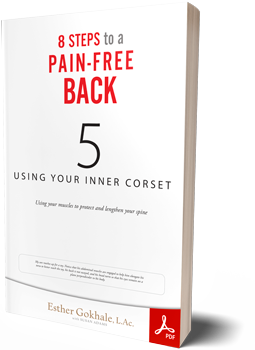
CAUTION: If you have back pain or a diagnosis or suspicion of herniation, stenosis, osteoporosis, or other spinal deterioration, you should consult your preferred health professional before practicing plank.
Let’s get started
Start with a baby version of low plank in which your knees remain on the floor. This creates a shorter span and requires less abdominal strength to hold you horizontal. From a kneeling position:
- Engage your inner corset—you will maintain it throughout the exercise.
- Roll your shoulders back, lengthen your neck, tuck your toes under.
- Lower yourself into your start position, elbows on the floor directly under your shoulders and forearms forward and parallel. You can also start in a baby Cobra position and lift your trunk away from the floor.
- Bring your trunk to horizontal. Maintain your torso, neck, and head in this straight, horizontal line.
- Initially, aim to hold baby plank for 5-10 seconds at a time. Repeat 5-10 times.
- Breathe steadily throughout.
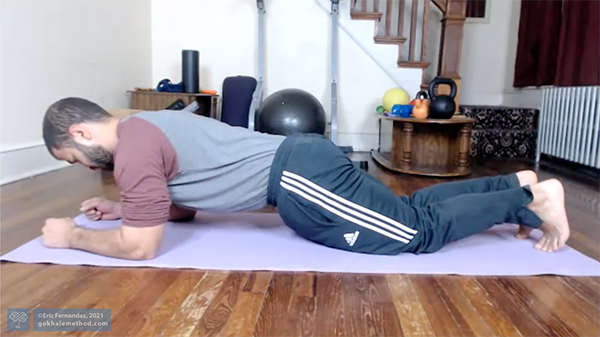
Baby plank develops healthy muscular strength, endurance, and coordination.
Full low plank
When doing plank on your knees is easy and you can breathe evenly, you can progress to doing the exercise with your legs straight and your weight on your toes.

Full low plank. You may need to drop back on the duration or repetitions initially, and then build up again.
Common Mistakes:
Neck tension:
Keep your neck lengthened with your head parallel to the floor; do not crane to look up. Tension in the back of the neck should not be attempting to lift you up. Neither do you want to drop your head down—rather, you want the deep muscles at the front of the cervical spine (longus colli) to support your neck, along with the inner corset.
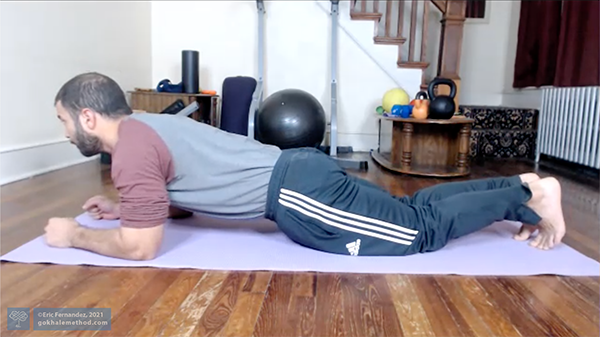
Do not tense the back of your neck and pull your head up.
Swaying the back:
It is important to not sag in the middle. Without a strong inner corset, the abdominal contents will hang downward, which will sway your lumbar spine and compress your discs and nerves. Practice the inner corset exercises consistently and you will soon be able to maintain a horizontal position.
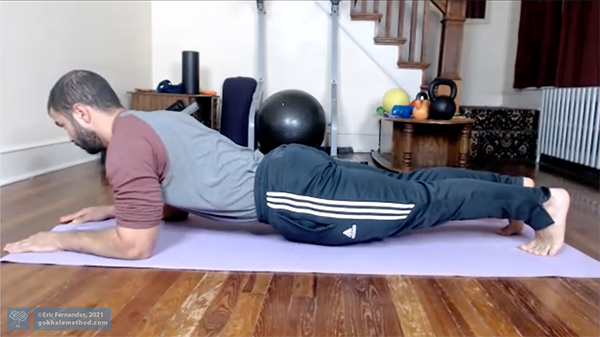
The lower back is dipping into a sway, with tell-tale shirt creases in the lumbar area.
Tucking the pelvis, rounding the back and shoulders:
You may find yourself tucking your pelvis, especially if you have been trained to do this when working your abdominals. You may also be working your glutes inappropriately—you want your inner corset to brace you, not clenched buttocks. Work with a more relaxed feeling in your pelvis and hips and allow your behind to remain behind you.

Rectus abdominis is flexing the spine and tucking the pelvis. Rounding the back and shoulders are also misguided efforts to push or lift up.
It can be tempting to push away as you take your weight in plank, rounding your shoulders. Resist this habit and allow your chest to remain closer to the ground. Drawing your shoulder blades together may help.
Make sure you are not tucking your pelvis or pushing your chest away from the ground, both of which will likely result in rounding your back.
If you would like to practice this great exercise for your back health, join Eric for a “low plank” Gokhale Exercise class on Friday, November 26 at 9:45 a.m. (Pacific Time). If you have not yet subscribed to the 1-2-3 Move program, sign up now for your 7-day Gokhale Exercise Free Trial.
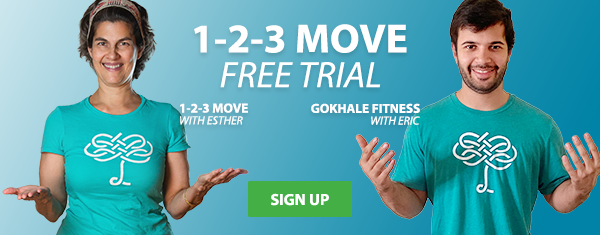
1-2-3 Move happens daily with Esther or guest teachers at 9:45 a.m.
Gokhale Fitness with Eric runs Mondays, Wednesdays, Fridays from 7–7:25 a.m.
(Pacific Time), and Tuesdays, Thursdays, Saturdays from 3–3:25 p.m. (Pacific Time)
Gokhale Moving Meditation with Roberta is Mondays at 2 p.m. and with Kathleen is Wednesdays at 12 p.m. (Pacific Time)

Comments
Add New Comment
Login to add commment
Login